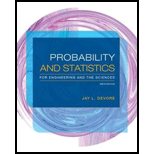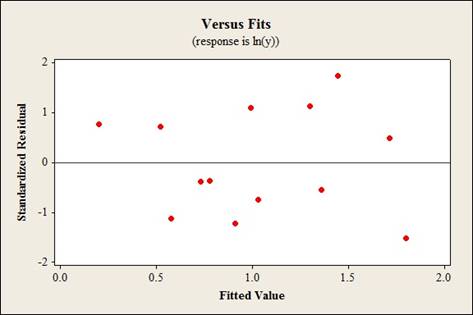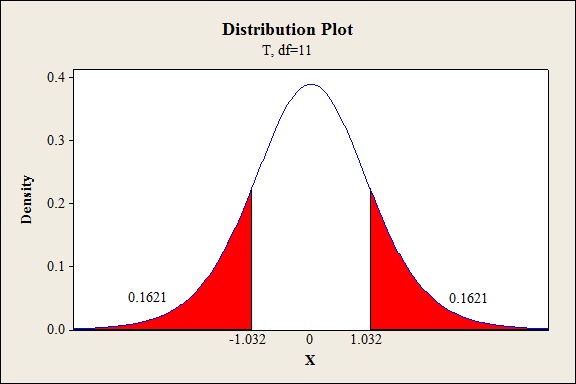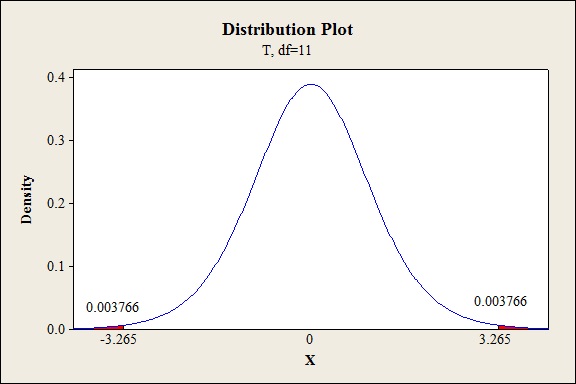
The following data on mass rate of burning x and flame length y is representative of that which appeared in the article “Some Burning Characteristics of Filter Paper” (Combustion Science and Technology, 1971: 103–120):
| x | 1.7 | 2.2 | 2.3 | 2.6 | 2.7 | 3.0 | 3.2 |
| y | 1.3 | 1.8 | 1.6 | 2.0 | 2.1 | 2.2 | 3.0 |
| x | 3.3 | 4.1 | 4.3 | 4.6 | 5.7 | 6.1 | |
| y | 2.6 | 4.1 | 3.7 | 5.0 | 5.8 | 5.3 |
a. Estimate the parameters of a power
b. Construct diagnostic plots to check whether a power function is an appropriate model choice. c. Test H0: β = 4/3 versus Ha: β < 4/3, using a level .05 test.
d. Test the null hypothesis that states that the
a.
Estimate the parameters of power model.
Answer to Problem 17E
The estimate the parameters of power model are 0.626 and 1.254x.
Explanation of Solution
Given info:
The data shows the mass rate of burning x and the length of flame y.
Calculation:
The power model is given below:
Where, y is transformed into ln(y), x is transformed into ln(x).
The linear function is
The estimates of the parameters
Where,
The table below shows the calculation of estimating the parameters:
| S. No | ln(y) | ln(x) | |||
| 1 | 0.2624 | 0.5307 | 0.139256 | 0.068854 | 0.281642 |
| 2 | 0.5878 | 0.7885 | 0.46348 | 0.345509 | 0.621732 |
| 3 | 0.4701 | 0.833 | 0.391593 | 0.220994 | 0.693889 |
| 4 | 0.6932 | 0.9556 | 0.662422 | 0.480526 | 0.913171 |
| 5 | 0.742 | 0.9933 | 0.737029 | 0.550564 | 0.986645 |
| 6 | 0.7885 | 1.0987 | 0.866325 | 0.621732 | 1.207142 |
| 7 | 1.0987 | 1.1632 | 1.278008 | 1.207142 | 1.353034 |
| 8 | 0.9556 | 1.194 | 1.140986 | 0.913171 | 1.425636 |
| 9 | 1.411 | 1.411 | 1.990921 | 1.990921 | 1.990921 |
| 10 | 1.3084 | 1.4587 | 1.908563 | 1.711911 | 2.127806 |
| 11 | 1.6095 | 1.5261 | 2.456258 | 2.59049 | 2.328981 |
| 12 | 1.7579 | 1.7405 | 3.059625 | 3.090212 | 3.02934 |
| 13 | 1.6678 | 1.8083 | 3.015883 | 2.781557 | 3.269949 |
| Total | 13.3529 | 15.5016 | 18.11035 | 16.57358 | 20.22989 |
=1.253
= –0.467
Thus, the estimates of the parameters are given below:
Similarly,
b.
Construct a diagnostic plot for checking the appropriate of power model.
Answer to Problem 17E
The diagnostic plot is given below:

Explanation of Solution
Calculation:
Software procedure:
Step-by-step procedure to construct a diagnostic plot is given below:
- Choose Stats>Regression> Regression.
- Select Simple and click OK
- Under Response, choose the column containing ln(y).
- Under Predictors, choose the column containing ln(x).
- Click Graphs, select residuals versus fits.
- Click OK.
Output obtained from MINITAB is given below:

The residual plot versus fitted values shows that the errors are randomly distributed with mean 0. This tells that the power model is appropriate to use for the given data.
The R-square value is 96% which tells that ln of mass rate of burning x can explain 96% of the variation in ln of flame length.
Hence, a power model is appropriate.
c.
Test the hypotheses
Answer to Problem 17E
There is sufficient evidence to conclude that
Explanation of Solution
Calculation:
That is, the slope coefficient equals to
That is, the slope coefficient is lesser than
Test statistic:
=–1.032
P-value:
Software procedure:
Step-by-step procedure to find the P-value is given below:
- Choose Graph>Probability distribution Plot>View Probability.
- Select t, enter 11 for degrees of freedom.
- Under Shaded Area tab, select X value and click on Both tails.
- Enter 1.032 for X value.
- Click OK.
Output obtained from MINITAB is given below:

Conclusion:
The P-value is 0.1621 and the level of significance is 0.05.
The P-value is greater than the level of significance is 0.05.
That is, 0.1621>0.05.
Thus, the null hypothesis is not rejected.
Thus, there is sufficient evidence to conclude that
d.
Test the hypothesis that the whether the median flame with 5.0 burning rate is twice the median flame length when the burning rate is 2.5 or not.
Answer to Problem 17E
There is no sufficient evidence to conclude the median flame with 5.0 burning rate is twice the median flame length when the burning rate is 2.5
Explanation of Solution
Calculation:
The median flame with 5.0 burning rate is twice the median flame length when the burning rate is 2.5 can be expressed as,
The hypothesis test is given below:
Test statistic:
=3.265
P-value:
Software procedure:
Step-by-step procedure to find the P-value is given below:
- Choose Graph>Probability distribution Plot>View Probability.
- Select t, enter 11 for degrees of freedom.
- Under Shaded Area tab, select X value and click on Both tails.
- Enter 3.26 for X value.
- Click OK.
Output obtained from MINITAB is given below:

Thus, the P-value is
Conclusion:
The P-value is 0.008 and the level of significance is 0.01.
The P-value is lesser than the level of significance.
That is 0.008<0.01.
Thus, the null hypothesis is rejected.
Thus, there is no sufficient evidence to conclude the median flame with 5.0 burning rate is twice the median flame length when the burning rate is 2.5.
Want to see more full solutions like this?
Chapter 13 Solutions
Probability and Statistics for Engineering and the Sciences
- You find out that the dietary scale you use each day is off by a factor of 2 ounces (over — at least that’s what you say!). The margin of error for your scale was plus or minus 0.5 ounces before you found this out. What’s the margin of error now?arrow_forwardSuppose that Sue and Bill each make a confidence interval out of the same data set, but Sue wants a confidence level of 80 percent compared to Bill’s 90 percent. How do their margins of error compare?arrow_forwardSuppose that you conduct a study twice, and the second time you use four times as many people as you did the first time. How does the change affect your margin of error? (Assume the other components remain constant.)arrow_forward
- Out of a sample of 200 babysitters, 70 percent are girls, and 30 percent are guys. What’s the margin of error for the percentage of female babysitters? Assume 95 percent confidence.What’s the margin of error for the percentage of male babysitters? Assume 95 percent confidence.arrow_forwardYou sample 100 fish in Pond A at the fish hatchery and find that they average 5.5 inches with a standard deviation of 1 inch. Your sample of 100 fish from Pond B has the same mean, but the standard deviation is 2 inches. How do the margins of error compare? (Assume the confidence levels are the same.)arrow_forwardA survey of 1,000 dental patients produces 450 people who floss their teeth adequately. What’s the margin of error for this result? Assume 90 percent confidence.arrow_forward
- The annual aggregate claim amount of an insurer follows a compound Poisson distribution with parameter 1,000. Individual claim amounts follow a Gamma distribution with shape parameter a = 750 and rate parameter λ = 0.25. 1. Generate 20,000 simulated aggregate claim values for the insurer, using a random number generator seed of 955.Display the first five simulated claim values in your answer script using the R function head(). 2. Plot the empirical density function of the simulated aggregate claim values from Question 1, setting the x-axis range from 2,600,000 to 3,300,000 and the y-axis range from 0 to 0.0000045. 3. Suggest a suitable distribution, including its parameters, that approximates the simulated aggregate claim values from Question 1. 4. Generate 20,000 values from your suggested distribution in Question 3 using a random number generator seed of 955. Use the R function head() to display the first five generated values in your answer script. 5. Plot the empirical density…arrow_forwardFind binomial probability if: x = 8, n = 10, p = 0.7 x= 3, n=5, p = 0.3 x = 4, n=7, p = 0.6 Quality Control: A factory produces light bulbs with a 2% defect rate. If a random sample of 20 bulbs is tested, what is the probability that exactly 2 bulbs are defective? (hint: p=2% or 0.02; x =2, n=20; use the same logic for the following problems) Marketing Campaign: A marketing company sends out 1,000 promotional emails. The probability of any email being opened is 0.15. What is the probability that exactly 150 emails will be opened? (hint: total emails or n=1000, x =150) Customer Satisfaction: A survey shows that 70% of customers are satisfied with a new product. Out of 10 randomly selected customers, what is the probability that at least 8 are satisfied? (hint: One of the keyword in this question is “at least 8”, it is not “exactly 8”, the correct formula for this should be = 1- (binom.dist(7, 10, 0.7, TRUE)). The part in the princess will give you the probability of seven and less than…arrow_forwardplease answer these questionsarrow_forward
- Selon une économiste d’une société financière, les dépenses moyennes pour « meubles et appareils de maison » ont été moins importantes pour les ménages de la région de Montréal, que celles de la région de Québec. Un échantillon aléatoire de 14 ménages pour la région de Montréal et de 16 ménages pour la région Québec est tiré et donne les données suivantes, en ce qui a trait aux dépenses pour ce secteur d’activité économique. On suppose que les données de chaque population sont distribuées selon une loi normale. Nous sommes intéressé à connaitre si les variances des populations sont égales.a) Faites le test d’hypothèse sur deux variances approprié au seuil de signification de 1 %. Inclure les informations suivantes : i. Hypothèse / Identification des populationsii. Valeur(s) critique(s) de Fiii. Règle de décisioniv. Valeur du rapport Fv. Décision et conclusion b) A partir des résultats obtenus en a), est-ce que l’hypothèse d’égalité des variances pour cette…arrow_forwardAccording to an economist from a financial company, the average expenditures on "furniture and household appliances" have been lower for households in the Montreal area than those in the Quebec region. A random sample of 14 households from the Montreal region and 16 households from the Quebec region was taken, providing the following data regarding expenditures in this economic sector. It is assumed that the data from each population are distributed normally. We are interested in knowing if the variances of the populations are equal. a) Perform the appropriate hypothesis test on two variances at a significance level of 1%. Include the following information: i. Hypothesis / Identification of populations ii. Critical F-value(s) iii. Decision rule iv. F-ratio value v. Decision and conclusion b) Based on the results obtained in a), is the hypothesis of equal variances for this socio-economic characteristic measured in these two populations upheld? c) Based on the results obtained in a),…arrow_forwardA major company in the Montreal area, offering a range of engineering services from project preparation to construction execution, and industrial project management, wants to ensure that the individuals who are responsible for project cost estimation and bid preparation demonstrate a certain uniformity in their estimates. The head of civil engineering and municipal services decided to structure an experimental plan to detect if there could be significant differences in project evaluation. Seven projects were selected, each of which had to be evaluated by each of the two estimators, with the order of the projects submitted being random. The obtained estimates are presented in the table below. a) Complete the table above by calculating: i. The differences (A-B) ii. The sum of the differences iii. The mean of the differences iv. The standard deviation of the differences b) What is the value of the t-statistic? c) What is the critical t-value for this test at a significance level of 1%?…arrow_forward
 Algebra: Structure And Method, Book 1AlgebraISBN:9780395977224Author:Richard G. Brown, Mary P. Dolciani, Robert H. Sorgenfrey, William L. ColePublisher:McDougal LittellAlgebra & Trigonometry with Analytic GeometryAlgebraISBN:9781133382119Author:SwokowskiPublisher:Cengage
Algebra: Structure And Method, Book 1AlgebraISBN:9780395977224Author:Richard G. Brown, Mary P. Dolciani, Robert H. Sorgenfrey, William L. ColePublisher:McDougal LittellAlgebra & Trigonometry with Analytic GeometryAlgebraISBN:9781133382119Author:SwokowskiPublisher:Cengage

